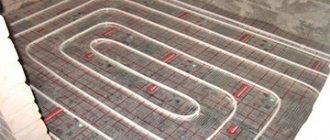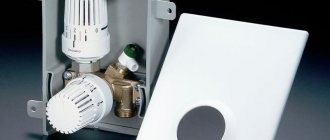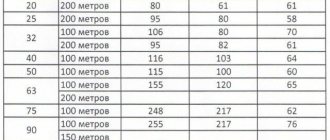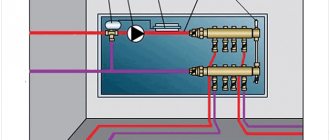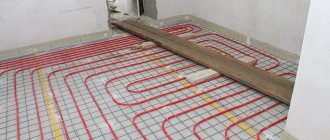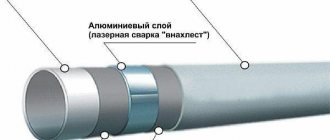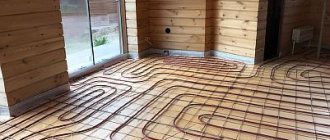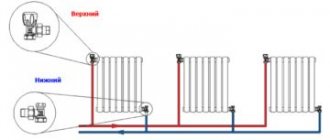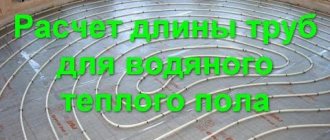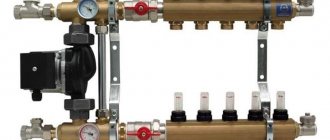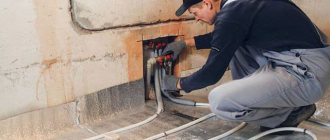The main reasons for the accumulation of air masses
Air often gets into the pipes when the system is depressurized.
The problem of the formation of air masses in modern heating systems is very pressing. All owners of private and country houses, without exception, face it.
One of the main reasons is depressurization of the system itself, problems in the risers and untimely replacement of individual devices. Often, air pockets form during the process of flushing and connecting individual elements to the heating radiator.
The formation of similar problems can also occur when work aimed at installing or installing a heating system is carried out incorrectly. In any case, this problem requires an urgent solution.
A scheduled release of air will be required before first use. The air must leave the underfloor heating pipe system before it is heated.
Most heating systems are able to function even after air bubbles enter the system.
In this case, circulation will be difficult due to the appearance of bubbles in the radiator, but the warm floor will stop heating if air gets into its system.
The small thickness of the pipes, combined with the peculiarity of the system, will not allow it to heat up, and the floors will be cold.
You can get rid of air during the operation of the system, but it is much easier to do this before the first cold weather sets in when the mechanism is not running. After some time, bubbles may appear again, so the system must be monitored and checked carefully, periodically bleeding the air.
Vent the air in the summer, before starting the heating system.
How does an automatic air vent work?
Let's figure out how an automatic air vent works, the cost of which is 2-3 times higher than manual devices. Such products are equipped with air release valves that function without outside intervention. The design of the product is a vertical barrel with a ½-inch threaded connection method. The body of the product is made of brass, and inside the device there is a plastic float. This float is connected to the spring-loaded air release valve and the cap.
Automatic air vents have ½ and 3/8 inch threads. The last option comes up rarely.
The operating principle of the automatic air valve is to perform the following tasks:
- If there is no air in the system, the chamber of the device is filled with water, which presses the float to the top. In this case, the spring-loaded valve is in the closed position.
- When air enters the system, the pressure decreases, so the float drops.
- When the pressure decreases to a certain value, the mass of the float device will overcome the spring, which will lead to the opening of the valve.
- The excess pressure will force air out of the circuit, after which the valve will close again.
What are the dangers of air jams?
If there are voids in the pipes, heating the floor will be less effective. If you do not pump the pipeline, the voids will increase and lead to a decrease in pressure.
Depending on the design features of the device, airiness can lead to:
- to freezing of pipes in corner rooms - when installing floors from central heating;
- to a complete or partial cessation of heating - in the presence of heating hydrofloors and radiator heating operating from the central heating of the entire house located in the basement;
- to partial or complete cessation of heating, the occurrence of emergency shutdowns of the boiler and freezing of CO - with floors operating from an autonomous heating system;
- to a complete or partial stop of heating, as well as to frequent interruptions in the operation of the boiler - if the house has heated floors and radiator appliances that operate from an individual heating source.
For your information! Taking into account all the design features: the number of loops in the room, the presence of separate wiring for each room, we can say with confidence that a complete cessation of circulation in the pipeline cannot occur.
Only if all loops of the circuit are clogged with plugs at the same time will the water stop moving along the main line through all rooms and floors of the house, as a result of which all heating will stop functioning.
How to bleed air yourself
Pumping a water floor is not difficult; you can do this procedure yourself.
However, it is worth noting that depending on the design of the structure, the process of removing air flow from the pipes varies.
#bleed air from the heated floor, #air in the pump, #starting the heated floor, #water heated floor
How to bleed air from a circuit operating from a circulation pump
To remove air from a sex circuit equipped with a pump, you must perform the following steps:
- It is necessary to close the flow meters on the manifold leading to all loops.
- Vent the circulation pump.
- Open the ball valve or Mayevsky valve on the comb, and one floor loop.
The process of opening the Mayevsky tap is to hold the white part of the valve with one hand so that it does not dangle. The second is to unscrew the valve located in the middle.
- Then you need to turn on the circulation pump at low speeds. The pressure should be 20% higher than normal.
- Turn off the pump and close the valve after water appears from the air vent.
- This procedure must be repeated several times, at intervals of several minutes, until all the air is drained.
- This action must be carried out with each loop. Repeat the process for 2 - 3 days until the air is completely bled out.
- Then the pump must be turned on to maximum and the entire pipeline must be purged.
Only after complete bleeding of the air masses should the heating floor be started. During operation, the circuit may become airy again, so it is recommended to periodically press out the air.
Bleed from gravity system
If you have a gravity-flow structure in which there are no release valves, the question arises - how to remove air from the underfloor heating system? You will have to wait until the air masses come out through the expansion tank.
In this case, the device should not be running and the water in it should be cooled. The process may take several days.
In a word, in order to bleed air bubbles from such a line, you need to turn off the boiler and motor and allow the hydrofloor to cool.
How to bleed air using automatic vents
Currently, there are special diverters or separators that automatically expel air masses from the circuit.
With their help, it is easy to bleed plugs, and they do not require special maintenance and care work.
Automatic diverters should be installed at the highest point of the heating pipeline, because this is where air accumulates.
There is no need to include them in the safety group, since there is no concentration of air masses there.
We expel the air using strong water pressure
It is theoretically possible to bleed off the air with high water pressure, but it is quite difficult to do. You will need a powerful pump with a pressure of more than 2 atmospheres to blow through the pipes.
But removing traffic jams using this method can only be done from an open system, with a small number of branches. In addition, this method leads to overfilling of the expansion barrel. Therefore, it is recommended to use it only if you have experience in carrying out similar work.
Pressing out plugs by draining water
This method is recommended to be used if a gravity-flow structure will be aired. A large amount of water is drained from below, and at the same time poured from above.
In this way you can bleed the plugs. They shift, break and are squeezed out of the pipeline.
Errors when installing water heated floors. Myths.
The most common myth is that it is impossible to heat a building only with warm floors - it is necessary to install radiators. Because heated floors are not able to warm up the building.
Mistake number 1.
In my opinion, the biggest mistake when installing any heating system is the lack of calculation of the building’s heat losses. When heat losses are not taken into account, then the heating system can be said to be done by eye.
Radiators are selected by eye, usually they are selected according to the size of the window or at the rate of 1 section per 10 square meters if sectional radiators are used. Warm floors are made by eye. Or they build radiators in rooms with heated floors “just in case.”
If you communicate with such an installer, kick him in the face. The end result will either be a non-working system, or you will spend extra money on building a heating system. Because the installer took care of your money and stuffed him with extra heating appliances.
Or vice versa - installed low-power heating appliances. In any case, these are losses.
Why does air appear in the system?
Before pumping a heated floor, make sure that the heating equipment is installed correctly and that technological standards are met. So, airing the circuit causes:
- high coolant temperature;
- pressure drops in any circuit;
- broken tightness of connections;
- incorrect installation of the manifold, lack of automated pressure relief valves;
- not pre-leveled floor, incorrect slope of pipes;
- lack of air pumping before starting the system.
Technical subtleties and nuances
In preparation for draining, it is necessary to study the structure of the collector in order to find and mark on the supply and return the location of the valves, marked as follows:
- servers are red;
- reverse flow - blue.
Connection diagram for a compressor for emptying the circuits of a heated floor system.
If you confuse the supply with the return, the drain system will not work - the check valve will block the pipeline.
Tips and tricks
As you know, the more complex the equipment, the higher its cost, while such a device is less reliable. Therefore, in order for the hydrofloor to work properly, you need to buy and install high-quality components.
Today there is a huge range of kits for installing water floors on the market. When choosing, you should carefully read their characteristics and features.
You can use a mechanically driven device, which is reasonably priced. In addition, the operation has been proven by many years of practice, so it rarely breaks down. Devices with a sulfur drive are more expensive, and there are more elements that can fail in this design.
When choosing a device for bleeding air, experts recommend paying attention to Mayevsky taps - they are reliable, durable and do not need adjustment.
Automatic devices have a more complex design and are more expensive. In addition, they become unusable when dirty.
As you can see, air locks lead to malfunctions, but this problem is easy to solve. The main thing is to bleed the air from the pipeline in time, and this must be done correctly and regularly.
Removing the air lock without draining the water
You probably know how to remove air from the heating system using standard methods. Having discovered a radiator that is not warming up, you need to open the Mayevsky tap in it with a screwdriver and release the air bubble. If old batteries are installed where there is no such valve, you can try removing them in other ways:
- The so-called pumping of the pipeline network is used in apartments of multi-storey buildings, provided that a tap is installed in the radiator to discharge water. Connect a hose to it directed into the sewer, open the valve to maximum and drain until the flow moving at high speed carries away the air lock.
- In a private home, Soviet steel batteries can be de-aired using a self-tapping screw. Wrap it at the base with FUM tape and screw it into the wall of the heating device with a screwdriver (closer to the top). Then unscrew the screw a couple of turns with a screwdriver, release the air and tighten it until it stops. In the summer, install a Mayevsky crane in this place.
- Removing air from cast iron batteries in a country house that are not equipped with air vents can be done in two ways: by completely recharging the system or by increasing the pressure (up to 2 Bar) with simultaneous heating. It is not recommended to unscrew the side plugs “on the fly”; then it will be difficult to pack them.
- Poor circulation and heat transfer may be a result of air accumulation in the mains pump housing. Unscrew the large screw installed at the end of the unit a couple of turns. When water drops appear from under the rubber ring, tighten it back.
Advice. To avoid air pockets during operation, install air bleed valves on all radiators. If the thickness of the metal wall does not allow cutting 3-4 turns of thread, weld a boss with a hole of the required diameter on top. In cast iron accordions, the valve is embedded in a side steel plug.
The self-tapping screw focus is also successfully used for improperly designed highways with hinges facing up or down (for example, to bypass doors and other building structures). How to remove an air bubble in a disadvantaged area of the pipeline by tightening a self-tapping screw, watch the video:
Air removal algorithm
Might be interesting
Thermal insulation
Self-adhesive thermal insulation: how to choose and apply?
Thermal insulation
What are thermal insulation materials: comparative…
Thermal insulation
How to insulate a roof from the inside and not make mistakes?
Thermal insulation
Roofing and drainage: heating rules
As the coolant moves through the system, gas accumulates at the highest points. For a heated floor system, this is a manifold distributor (comb). Mayevsky taps or automatic air exhaust devices are screwed into them during installation.
Below is the standard sequence of correct actions:
- Many modern pumps of this type are equipped with a step speed controller. It is set to position “1”, which corresponds to minimum performance. It will take more time, but the removal of gases will be accurate.
- Overlap all contours except one. Further, similar operations are performed sequentially in other areas.
- The screw of the Mayevsky primary circuit valve is turned with a slotted screwdriver in a counterclockwise direction. Before this, the polymer insert is turned with the hole down, and a suitable container is placed to collect the liquid.
- After the air has escaped, the screw is turned in the opposite direction until the tap is completely closed.
- Despite the fact that the minimum engine speed is set, the circuit will have to be pumped repeatedly. After the first release of gases, the pump is turned off. Wait for air to accumulate in the tap, open the tap. Next, power is supplied to the electric drive again, and the coolant is circulated at low speed for several minutes.
- This procedure is repeated 3-4 times. Afterwards, turn off this circuit with a tap and move on to the next one.
Typical pump with red shaft speed control knob
If the pump is installed above the comb, or only a standard unit (heating boiler) is used, air can also be released from it. To do this, slightly loosen the screw located in the center of the cover. In the picture above it is marked with an arrow.
After completing the entire set of work actions, the pressure will need to be raised to the nominal level. It should be understood that during this procedure air will again enter the system. Therefore, it is possible that we will have to release it again.
Formation of air masses in a heated floor system
A pump is needed to bleed the system.
How to bleed air accumulated in the system will depend on the incident that led to such a result.
Some circumstances require immediate intervention, while others are not capable of causing significant damage to the system.
If the heated floor was installed with noticeable differences, it is worth acquiring an additional pump for pumping the coolant.
It is recommended to install several automatic air vents that will help bleed air masses from the system. One is installed on the return lines, while the second should be on the supply.
Running the circulation pump will also help expel excess air. The more air that has accumulated, the louder the circulation pump will operate. It is worth paying attention that the system must be pumped at maximum speeds. This will significantly save time and allow you to completely remove air from the system. If it was recently pumped, but the air has already collected again, the problem may be in the pump itself.
With the comb installed, each circuit is closed in turn, and the air vent must be open on each of them. It is necessary to bleed air gradually, so after cleaning the first circuit, the next one opens. The descent is carried out in stages and at the moment of bleeding only one circuit should be open.
If this procedure does not give the expected result, the next air release should be carried out no earlier than in a few days.
To properly clean the system, a person must understand the structure of the comb and understand the principle of its operation. If you do not have the necessary knowledge, you should seek help from specialists. For more information on releasing air, watch this video:
Recently, separators have become increasingly popular, whose function is to automatically remove air bubbles from the system, which significantly simplifies the further operation of the entire system.
Features of choosing air vents
Not everyone knows where to start choosing an automatic air vent. In order for the product to serve for a long time and without failure, it is recommended to buy products of European or domestic production, but not cheap Chinese counterfeits. Buying a cheap automatic graduate can cause the following adverse consequences:
- Passing not only air, but also coolant through the valve. In this case, a puddle of water will be detected under the radiators or in the places where the air vents are installed.
- The product is jammed, so it will not work.
- Rapid deterioration.
Although automatic type safety valves have a shorter service life than manual ones, they must serve without fail for at least 10 years. Manual products have a service life of over 15 years, so instead of buying a cheap machine, it is better to give preference to a manual device. This will allow you to win not only in terms of savings, but there will also be no problems with air bleeding.
To choose good quality Mayevsky uranium, you need to pay attention to the following criteria:
- The presence of a handle allows you to conveniently open the valve for bleeding air. The disadvantage of faucets with handles is that they can be accessed by children, who are quite capable of opening them. Installation of such outlets with handles is appropriate only in hard-to-reach places; in other cases, it is recommended to install conventional products with a key or a screwdriver.
- To avoid losing the special bleeder key, it should be placed on the wall next to the radiator. This will prevent you from losing the key, and will also allow you to quickly bleed the air.
- Buy products with anodized coating. This spraying allows you to protect the metal from the occurrence of oxidative processes.
- If your budget allows, you can purchase a product that can trap air bubbles. However, such manual air vents do not differ much in cost from automatic air vents.
